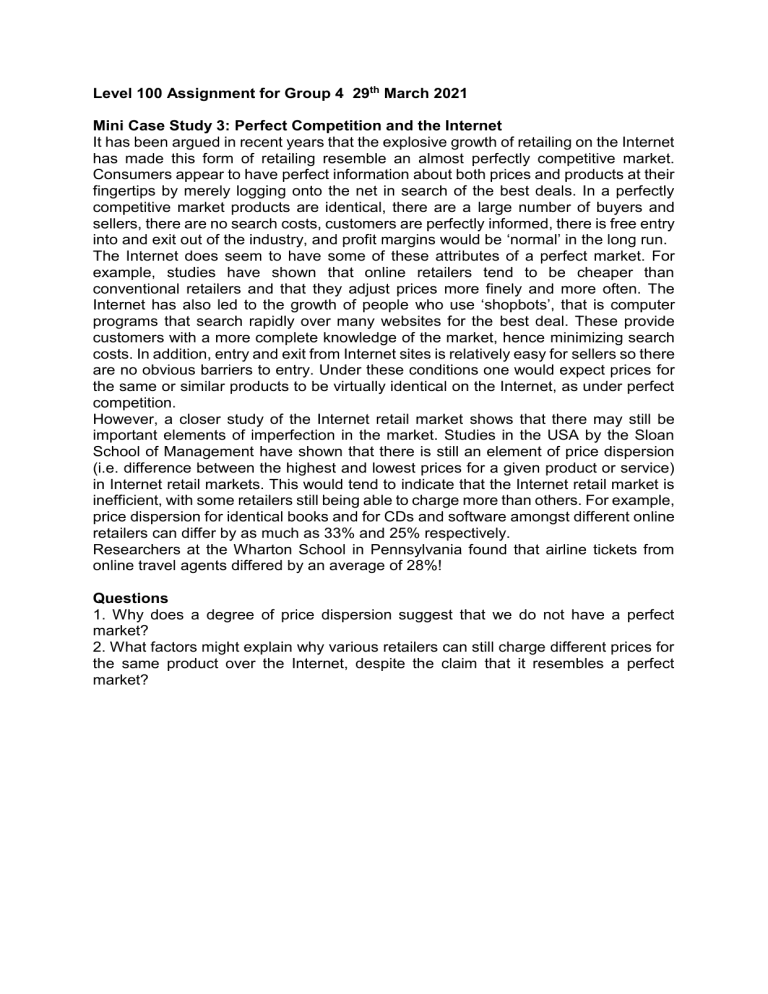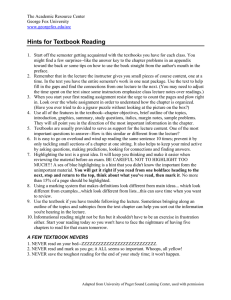
Level 100 Assignment for Group 4 29th March 2021 Mini Case Study 3: Perfect Competition and the Internet It has been argued in recent years that the explosive growth of retailing on the Internet has made this form of retailing resemble an almost perfectly competitive market. Consumers appear to have perfect information about both prices and products at their fingertips by merely logging onto the net in search of the best deals. In a perfectly competitive market products are identical, there are a large number of buyers and sellers, there are no search costs, customers are perfectly informed, there is free entry into and exit out of the industry, and profit margins would be ‘normal’ in the long run. The Internet does seem to have some of these attributes of a perfect market. For example, studies have shown that online retailers tend to be cheaper than conventional retailers and that they adjust prices more finely and more often. The Internet has also led to the growth of people who use ‘shopbots’, that is computer programs that search rapidly over many websites for the best deal. These provide customers with a more complete knowledge of the market, hence minimizing search costs. In addition, entry and exit from Internet sites is relatively easy for sellers so there are no obvious barriers to entry. Under these conditions one would expect prices for the same or similar products to be virtually identical on the Internet, as under perfect competition. However, a closer study of the Internet retail market shows that there may still be important elements of imperfection in the market. Studies in the USA by the Sloan School of Management have shown that there is still an element of price dispersion (i.e. difference between the highest and lowest prices for a given product or service) in Internet retail markets. This would tend to indicate that the Internet retail market is inefficient, with some retailers still being able to charge more than others. For example, price dispersion for identical books and for CDs and software amongst different online retailers can differ by as much as 33% and 25% respectively. Researchers at the Wharton School in Pennsylvania found that airline tickets from online travel agents differed by an average of 28%! Questions 1. Why does a degree of price dispersion suggest that we do not have a perfect market? 2. What factors might explain why various retailers can still charge different prices for the same product over the Internet, despite the claim that it resembles a perfect market? Have You Bought This Textbook? As all of you know full well, college textbooks are expensive. And, at first, it may seem as though there are few substitutes available for the cash-strapped undergraduate. After all, if your professor assigns Smith’s Principles of Biology to you, you cannot go out and see if Jones’ Principles of Chemistry is perhaps cheaper and buy it instead. As it turns out, as some recent work by Judy Chevalier and Austan Goolsbee1 discovered, even when instructors require particular texts, when prices are high students have found substitutes. Even in the textbook market student demand does slope down! Chevalier and Goolsbee collected data on textbooks from more than 1600 colleges for the years 1997–2001 to do their research. For that period, the lion’s share of both new and used college textbooks was sold in college bookstores. Next, they looked at class enrollments for each college in the large majors, economics, biology, and psychology. In each of those classes they were able to learn which textbook had been assigned. At first, one might think that the total number of textbooks, used plus new, should match the class enrollment. After all, the text is required! In fact, what they found was the higher the textbook price, the more text sales fell below class enrollments. So what substitutes did students find for the required text? While the paper has no hard evidence on this, students themselves gave them lots of suggestions. Many decide to share books with roommates. Others use the library more. These solutions are not perfect, but when the price is high enough, students find it worth their while to walk to the library! Thinking Practically 1. If you were to construct a demand curve for a required text in a course, where would that demand curve intersect the horizontal axis? 2. And this much harder question: In the year before a new edition of a text is published, many college bookstores will not buy the older edition. Given this fact, what do you think happens to the gap between enrollments and new plus used book sales in the year before a new edition of a text is expected? Date of Submission: 1st April, 2021 Thinking Practically 1. For a student having purchasing a textbook and spending time in library as substitutes, he will prefer spending time in the library rather than purchasing the book if the book is expensive, and out of his budget. However, one knows that when the book is demanded on horizontal axis it implies that the price charged for that book zero. Since, at zero price everyone would like to have that book, therefore, the required textbook will be the total enrollment in that course. The demand curve between will look like the following

